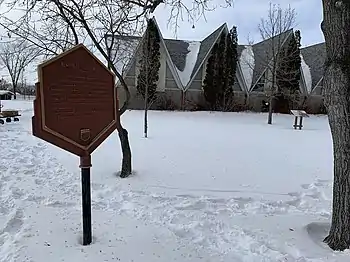East Reserve
The East Reserve was a block settlement in Manitoba set aside by the Government of Canada exclusively for settlement by Russian Mennonite settlers in 1873.[1] Most of the East Reserve's earliest settlers were from the Kleine Gemeinde or Bergthaler Mennonite churches.

After signing Treaty 1 with the Anishinabe and Swampy Cree First Nations, the Canadian government sent William Hespeler to Russia to recruit Mennonite farmers to the region. The area was first visited by Jacob Yost Shantz, a Swiss Mennonite from Ontario, who wrote a Narrative of a journey to Manitoba, a report which helped convince Russian Mennonites to move to the area. In 1873 Mennonite delegates from the Russian Empire, (David Klassen, Jacob Peters, Heinrich Wiebe, and Cornelius Toews), visited the area and agreed to a Privilegium outlining religious freedom, military exemption, and land. This land became known as the East Reserve, because it was east of the Red River. Mennonite settlers first arrived in the confluence of the Red River and Rat River and gathered in immigration sheds that Shantz had set up nearby before spreading across the region and selecting numerous village sites. In the years that followed, thousands of Mennonites settled in this area.[2] The East Reserve was initially set aside exclusively for Mennonite settlement and settlers established dozens of villages, a few of which remain today, including Steinbach, now an independent municipality, Grunthal, Kleefeld, and Blumenort. The reserve was governed using the system the Mennonites had learned in Prussia. Each village had a Schulz, or mayor, while the whole reserve had an Oberschulz.
The East Reserve eventually opened up to settlement from other groups and became known as the Rural Municipality of Hanover. Briefly known as "The Mennonite Reserve" the name was quickly changed to "East Reserve" after a second reserve was established. The land of East Reserve was viewed by many as limited and unsuitable for farming, so a second reserve, called the West Reserve on the west side of the Red River was established in 1876.[3] A smaller Scratching River settlement was also established in 1875 on the Morris River.
In 1877, Lord Dufferin visited the Mennonite villages of the East Reserve and, from a rise just west of Steinbach could see "half a dozen villages" in the distance. More than 1000 people showed up to greet him.[4]
In 1880, the Manitoba government renamed the East Reserve as Hespeler and a year later, in 1881, the reserve was divided between the R.M. of Hespeler, no longer in existence, and the Rural Municipality of Hanover, which is slightly larger than the original East Reserve.[5]
References
- Francis, E.K. (1955). In Search of Utopia. D.W. Friesens and Sons.
- Braun, Ernest N. and Glen R. Klassen (2015). Historical Atlas of the East Reserve. Manitoba Mennonite Historical Society.
- Schroeder, William and Helmut T. Huebert (1996). Mennonite Historical Atlas. Springfield Publishers.
- Braun, Ernest N. and Glen R. Klassen (2015). Historical Atlas of the East Reserve. Manitoba Mennonite Historical Society.
- Penner, Lydia (1982). Hanover 100 Years. R.M. of Hanover.
